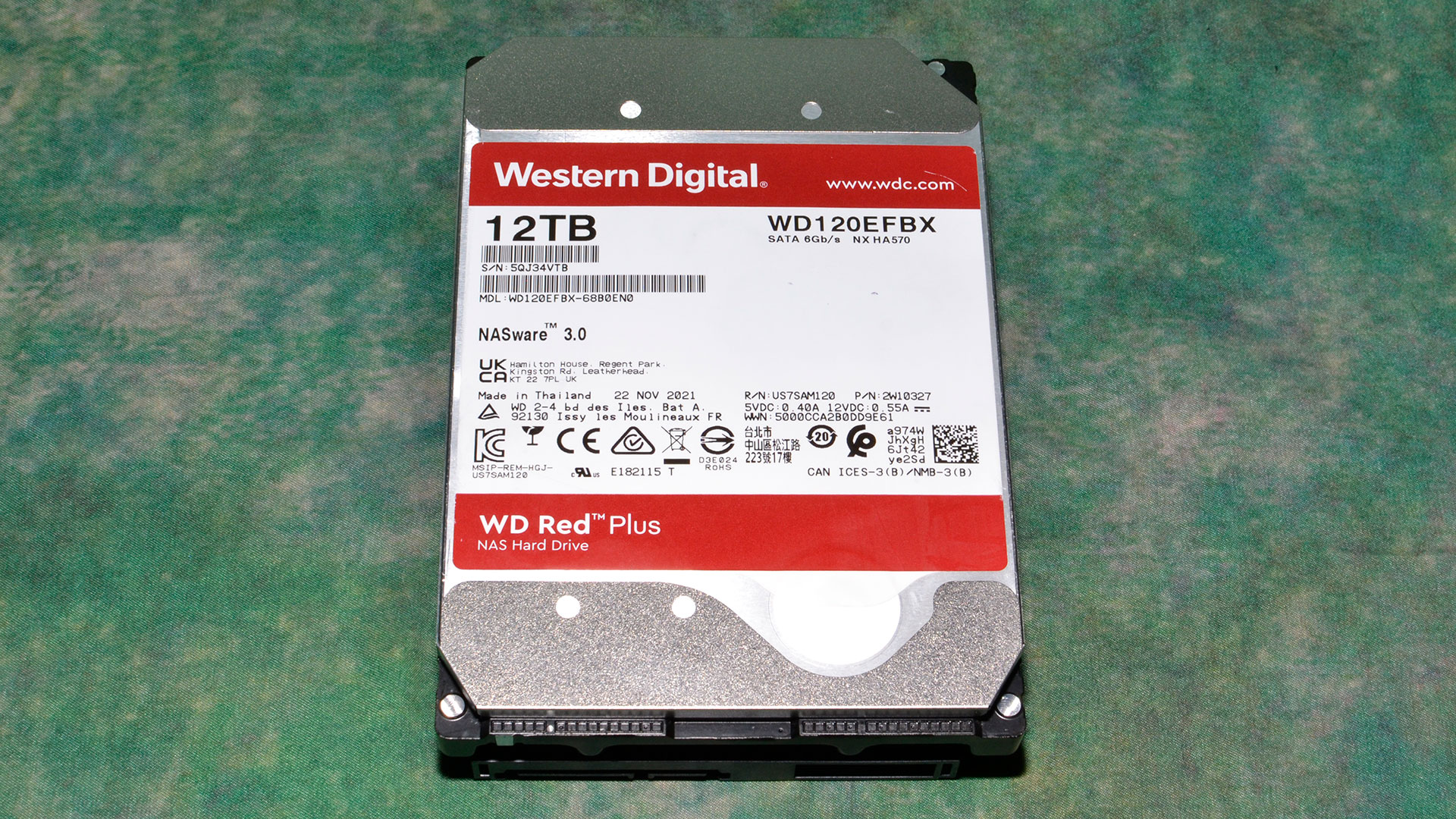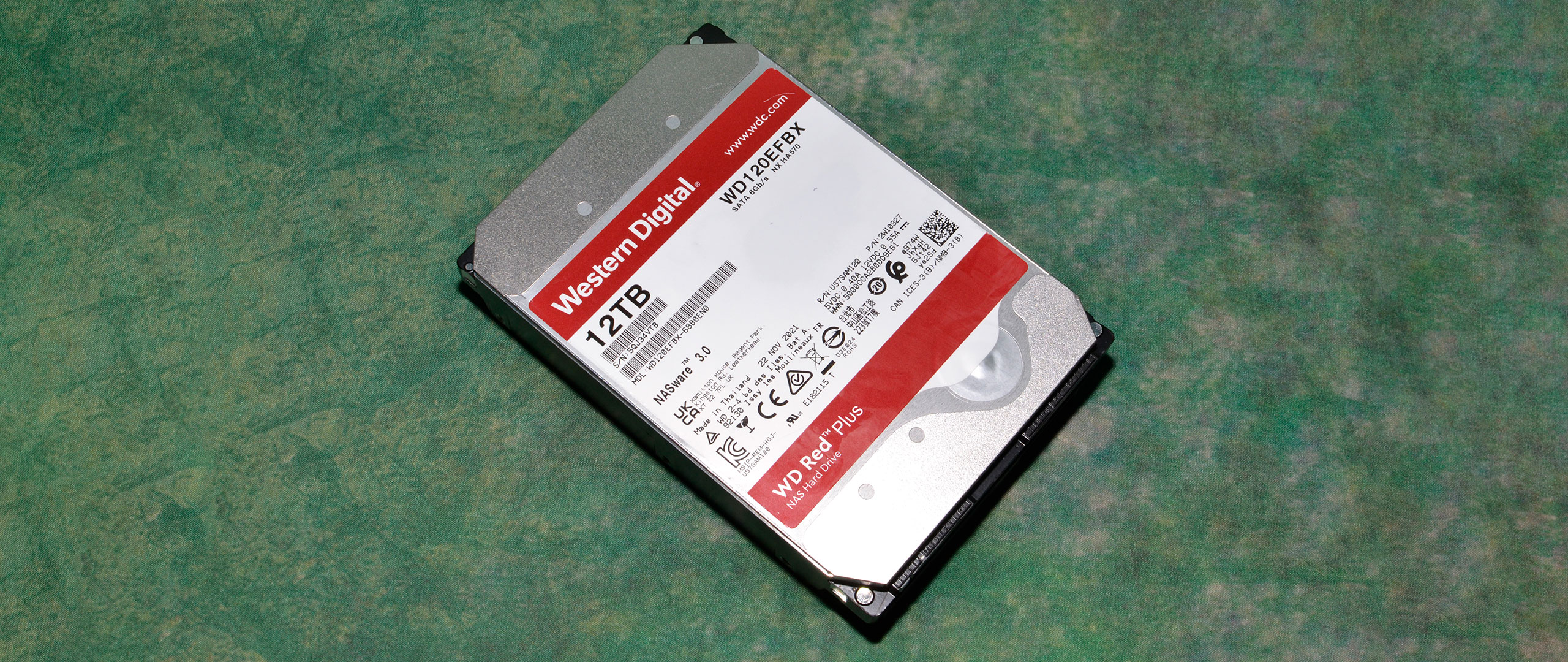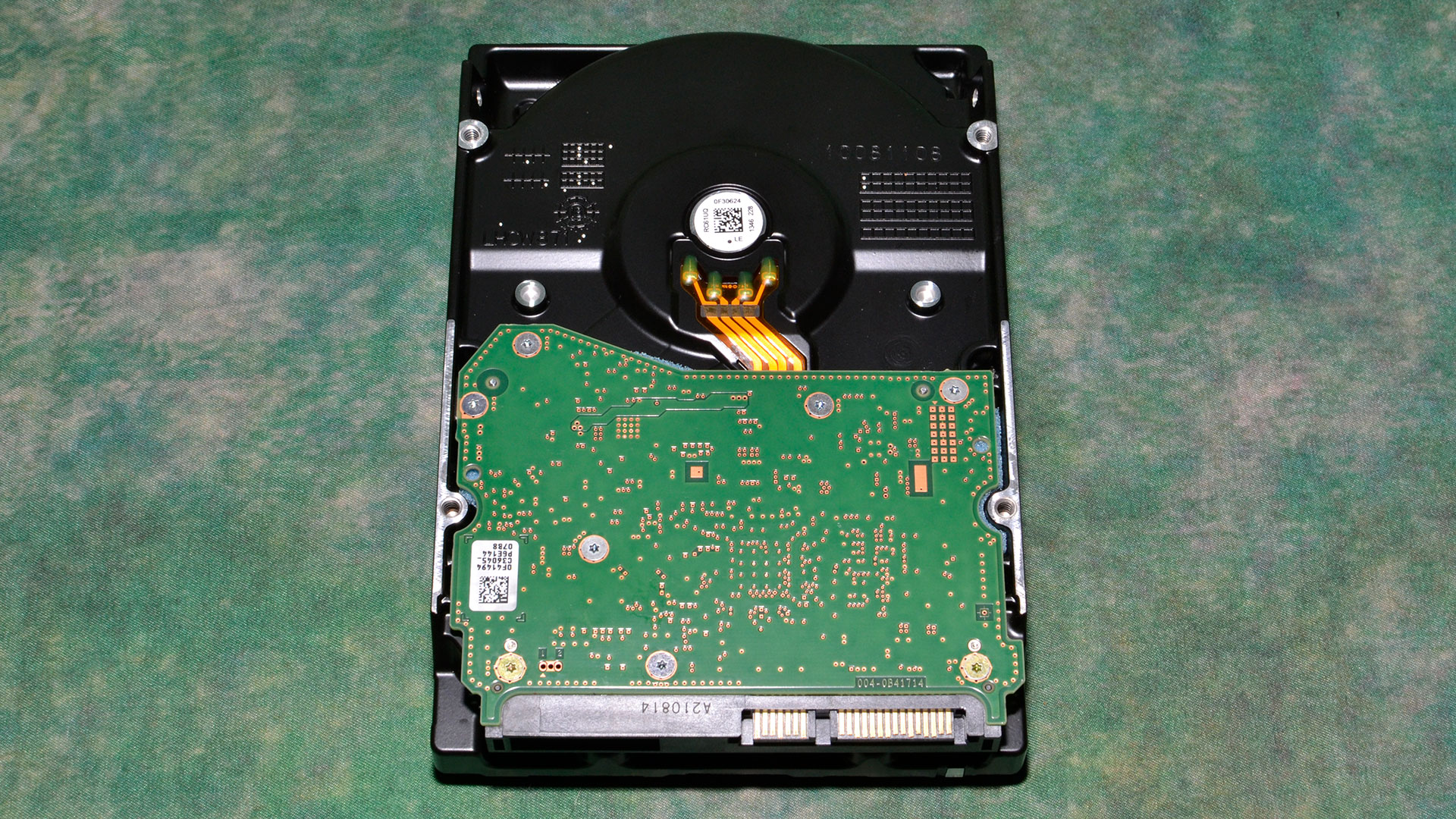Tom's Hardware Verdict
The WD Red Plus is a cheaper, slower version of the Red Pro with a shorter warranty. It trades performance for quiet operation which yields relatively poor performance for its specifications, but it is still useful for NAS.
Pros
- +
7200-RPM spindle speed
- +
CMR technology
- +
256MB of cache
- +
Quiet and relatively efficient
Cons
- -
Lackluster performance, given its specs
- -
Shorter, three-year warranty
Why you can trust Tom's Hardware
The WD Red Plus is a NAS hard drive designed to be a quieter, cheaper solution than the Red Pro. This comes at the cost of performance and warranty but positions it well for a budget offering on our list of best hard drives. It’s not as cheap as entry-level hard drives but offers an extra year of warranty and also a larger capacity range. It’s also less expensive than higher-end NAS models but faces competition from other angles. However, as it’s optimized for NAS and multi-drive environments, it is a better pick for NAS than retail alternatives like the Seagate BarraCuda Pro.
The 12TB Red Plus runs at 7200 RPM and uses CMR technology with a 256MB DRAM cache, which is a solid combination. However, its performance seems to fall short of expectations, and it doesn’t have the OptiNand technology of the Red Pro. This puts the Red Plus in a special spot, making it the best choice if you want a quieter, cooler multi-drive NAS solution.
Specifications
| Product | WD Red Plus |
|---|---|
| Capacity | 12TB |
| Model # | WD120EFBX |
| Pricing | $189.99 |
| Cost per TB | $15.83 |
| Interface | SATA 6 Gb/s |
| Form Factor | 3.5" |
| Technology | CMR |
| RPM | 7200 |
| Sustained Transfer Rate | Up to 196 MBps |
| Cache | 256MB |
| Operating Power | 6.3W |
| Noise | 29 dBA |
| Workload Rate Limit | 180 TB/year |
| MTBF | 1 million hours |
| Warranty | 3-year |
The WD Red Plus comes in a large variety of capacities with differing spindle speeds, and cache capacities. Today we’re looking at the 12TB model that is rated for 7200 RPM with a 256MB cache - it climbs to 512MB at 14TB - and an internal transfer rate of 196 MB/s. This is slower than its primary competition, the IronWolf NAS HDD, which is rated for 210 MB/s. Both drives have a three-year warranty with an MTBF rating of 1 million hours and a workload rate limit of 180 TB/year. Both also use CMR rather than SMR technology. The IronWolf, for its part, does pull more power on paper.
The 12TB Red Plus is currently $189.99, with a higher cost per terabyte than standard hard drives. It’s priced near the IronWolf but also the Seagate BarraCuda Pro. The latter has better performance and a longer warranty which makes it essentially a larger version of the FireCuda. The BarraCuda Pro, however, is not NAS-optimized and is also not designed for quiet operation like the Red Plus.
Software and Accessories
WD offers downloads for its Digital Dashboard and its version of Acronis True Image on its website. The first is useful for monitoring drive health and the latter enables you to image and clone your drives.
A Closer Look




The WD Red Plus doesn’t look special, but it is optimized for NAS. It’s designed to operate in a multi-drive environment and also has the NASaware firmware that’s used in the Red Pro. This bumps its warranty up an extra year versus entry-level internal storage like the Blue and Toshiba X300. The capacity range is also larger than the Blue’s, stripping away one of the X300’s benefits as the 12TB Red Plus is cheaper.
MORE: Best SSDs
Get Tom's Hardware's best news and in-depth reviews, straight to your inbox.
MORE: Best External SSDs and Hard Drives
MORE: How We Test HDDs And SSDs
MORE: All SSD Content

Shane Downing is a Freelance Reviewer for Tom’s Hardware US, covering consumer storage hardware.
-
bit_user Replyit doesn’t have the OptiNand technology of the Red Pro
Be aware that data recovery is probably impossible on OptiNAND drives, should anything happen to the OptiNAND chip.
Because NAND uses charge storage, it's conceivable the bits on the platters will outlast those in the OptiNAND chips. I wouldn't trust them to last too long after the warranty period. -
LaminarFlow Sure this is not the fastest drive, but honestly for 90% of the home/small office NAS applications, you are limited by network bandwidth. All modern drives will cap off the 1GbE on most situations, and 2.5GbE cost significantly more to setup. Heck, it's not even available as a standard feature on most Synology entry level NAS.Reply
I take quieter/cooler drives at 5400/5800 rpm any day over 7200 ones. Too bad they don't offer it anymore with 10TB+ capacity. -
bit_user Reply
It's worth considering RAID rebuild times. I don't like it when they take longer than 24h.LaminarFlow said:Sure this is not the fastest drive, but honestly for 90% of the home/small office NAS applications, you are limited by network bandwidth.
Honestly, I find it a little weird that it's not more economical for them to use fewer, higher-capacity platters, which is what ultimately determines peak sequential transfer speeds. -
lmcnabney Still too expensive at $16.70/TB. NAND is almost down to $30. Tick Tock spinning rust.Reply -
Ogotai Reply
maybe where you are, but here, mechanical hdds are still less expensive then ssds 2tb +lmcnabney said:Still too expensive at $16.70/TB. NAND is almost down to $30. Tick Tock spinning rust -
bit_user Reply
Where can you get 12 TB of SSDs for $360lmcnabney said:Still too expensive at $16.70/TB. NAND is almost down to $30. Tick Tock spinning rust.
Is that storage you'd really entrust your data to?
The problem is that you're not proposing a realistic alternative. You're just finding the cheapest SSD you can and extrapolating it as if it's a comparable option. It would be like me taking a 18 TB drive costing $250 and saying that HDD storage is $13.89/TB. It only applies to that specific drive. Presenting it as a ratio incorrectly implies that you could get a 2 TB HDD for $27.78, which I assure you that you cannot.
Instead of narrowly focusing on cost, it's better to focus on where HDDs make the most sense:
Large-capacity storage
Offline data retention, where the cheap QLC SSDs you keep quoting are especially bad.
For everything else, go ahead and use SSDs. -
sabicao Non-recoverable errors per bits read: 1 in each 10^14 - thanks, but no, thanks!Reply
Not while you have WD Gold or Seagate IronWolf Pro not that much more expensive to choose from. -
lmcnabney Reply
The problem is that there are only three manufacturers of HDD and they have decided not to compete with each other. Prices have been dropping steadily (price per MB/GB/TB) since they were invented decades ago until three years ago. Since 2020 the price for the exact same type of drive and capacity has been rock solid and newer/larger drives just have higher prices. Kind of like GPUs.bit_user said:The problem is that you're not proposing a realistic alternative.
Data centers are already gearing up to make the move to NAND. HDD may still cost 50-60% less, but they take up more room, consume more power, and perhaps most importantly, they produce more heat. They are also an order of magnitude slower in performance. The net costs are approaching parity. By keeping HDD prices higher instead of dropping to maintain a strong value position the industry is dooming itself. It is maintaining some profit margin now despite a huge drop in units sold.
We are already seeing the endgame. 4+ TB NAND devices have been plummetting in price and entering the full consumer market. They have even gotten under $200 for 4TB. This makes sense. Adding more storage, especially in the 2.5" size format, just scales with the price of NAND chips. When manufacturing at scale it is cheaper to make a 20TB 2.5" SATA drive than 20 1TB NVME drives that sell for under $40 each. Once higher capacity SSDs leave their specialty niche and go after consumers the HDD market is done. The industry's solution to this is to keep a strong price advantage over NAND, but they just don't want to do it. -
bit_user Reply
Yeah, though I think it's a minimum spec and it still amounts to 1 bit per 100 Tb (12.5 TB = ~1 drive read). It's a little worrisome, especially if it could lead to drives being flagged as failed, during a scrub.sabicao said:Non-recoverable errors per bits read: 1 in each 10^14 - thanks, but no, thanks! -
bit_user Reply
There are other explanations than them "deciding not to compete with each other". Have you read about HAMR drives? The reason they're doing that is conventional recording densities have basically hit a wall.lmcnabney said:The problem is that there are only three manufacturers of HDD and they have decided not to compete with each other. Prices have been dropping steadily (price per MB/GB/TB) since they were invented decades ago until three years ago. Since 2020 the price for the exact same type of drive and capacity has been rock solid and newer/larger drives just have higher prices.
The way HDDs get cheaper is by increasing density, so they can either offer the same capacity using fewer platters or offer more capacity with the same number of platters. It's not by magic. There's no natural law of physics that says everything technological must get cheaper with time. Just look at automobiles: they've pretty consistently gotten more expensive, even though they're based on technology and there's been pretty vibrant competition in that industry.
So, if conventional platter densities stopped increasing and HAMR adds cost and is slow to ramp up, then the natural expectation should be a plateauing of prices!
Did you ever look at the idle & active power specs for a datacenter SSDs, or are you just assuming they match the consumer SSDs you're familiar with?lmcnabney said:Data centers are already gearing up to make the move to NAND. HDD may still cost 50-60% less, but they take up more room, consume more power, and perhaps most importantly, they produce more heat.
There are lots of cases where performance doesn't matter so much. Backups and near-line storage, for example. Most of the data in "the cloud" is just sitting there, so you don't need to put it on the highest-performance devices.lmcnabney said:They are also an order of magnitude slower in performance.
You're focusing too much on the current market correction in SSDs as representing a trend. It certainly won't continue apace.lmcnabney said:The net costs are approaching parity.
So, if you divide these supposed profits by the volume of HDDs sold, how much do you estimate they could shave off the cost of each drive?lmcnabney said:By keeping HDD prices higher instead of dropping to maintain a strong value position the industry is dooming itself. It is maintaining some profit margin now despite a huge drop in units sold.
Controllers have a limited number of channels, so now you need either more controllers or bigger ones. Adding NAND chips also increases power consumption. Finally, adding more components results in greater chance of failure, which means you need to add some redundancy. Yes, it does scale, but it's not linear.lmcnabney said:We are already seeing the endgame. 4+ TB NAND devices have been plummetting in price and entering the full consumer market. They have even gotten under $200 for 4TB. This makes sense. Adding more storage, especially in the 2.5" size format, just scales with the price of NAND chips. When manufacturing at scale it is cheaper to make a 20TB 2.5" SATA drive than 20 1TB NVME drives that sell for under $40 each.
The best way to scale is to get higher-density NAND chips. Those will come, but at a higher price (though still more cost-effective than today).
At some point, the cost of adding additional NAND cells via denser process nodes or stacking more 3D layers will increase so much that the cost per bit will no longer decrease. I don't know when it will happen, but it inevitably will. At that point, I guess you'll blame "lack of competition" for prices ceasing to fall.
The lowest cost per GB is the consumer market. Try taking a look at datacenter SSD prices, some time.lmcnabney said:Once higher capacity SSDs leave their specialty niche and go after consumers the HDD market is done.
No, the industry's solution is to have a foot in both markets. All the big HDD makers also sell SSDs. They compete where there's money to be made. But, they're obviously not going to operate at zero profit or a loss, if they can possibly help it.lmcnabney said:The industry's solution to this is to keep a strong price advantage over NAND, but they just don't want to do it.
Right now, the state of the NAND industry is dire, which is why it's misleading to read too much into current pricing.
https://www.tomshardware.com/news/phison-chief-expects-bankruptcies-in-nand-industry